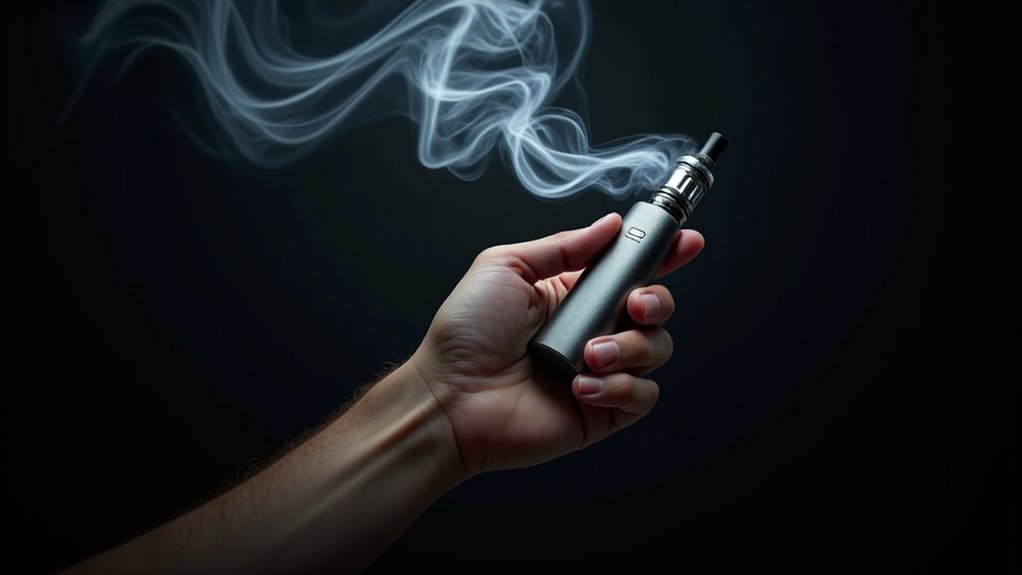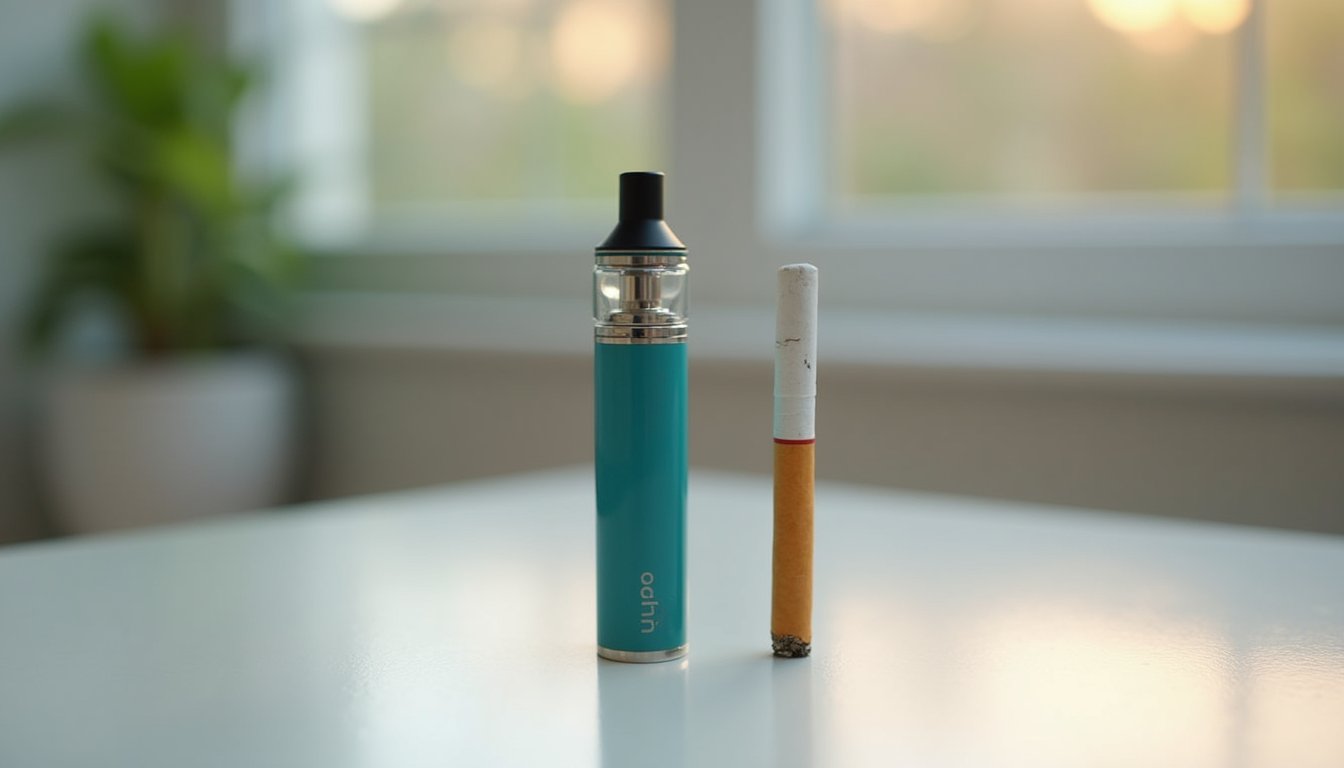Yes, vaping causes powerful addiction through nicotine’s rapid impact on your brain’s reward system. When you vape, nicotine triggers an immediate dopamine release, creating intense pleasure and reinforcing continued use. You’ll develop tolerance over time, requiring higher doses to achieve the same effects. E-cigarettes are particularly dangerous for teens, whose developing brains are more susceptible to addiction. Understanding the science behind vaping addiction can help you make informed decisions about your health.
Understanding Nicotine’s Role in E-Cigarette Dependency

How does nicotine drive e-cigarette addiction? When you vape, nicotine rapidly activates your brain’s reward system, triggering dopamine release that reinforces continued use. Your body develops tolerance over time, requiring higher doses to achieve the same effects. The introduction of protonated nicotine salts made e-cigarettes significantly more addictive by allowing users to inhale higher concentrations with less throat irritation. Research shows that the unlimited usability of e-cigarettes contributes significantly to their addictive nature.
The physiological factors of nicotine dependency are particularly concerning among individuals of different life stages, who’re starting e-cigarette use at younger phases with more concentrated products. You’ll experience withdrawal symptoms like irritability and anxiety when nicotine levels drop, creating a cycle where vaping temporarily relieves the very distress it causes. Research shows young as eleven year olds have experimented with vaping in Scotland.
Socioeconomic considerations show this trend affects diverse demographics across the U.S., with e-cigarettes becoming the dominant tobacco product among youth. The high-nicotine formulations in modern e-cigarettes deliver more potent doses, accelerating the path to addiction through efficient delivery systems.
The Science Behind Vaping Addiction
The biological mechanisms driving vaping addiction extend far beyond simple nicotine dependence. When you vape, nicotine rapidly binds to acetylcholine receptors in your brain, triggering dopamine release through the mesolimbic system. This process creates powerful reward pathways that become increasingly dysregulated with continued use. A single pod can contain as much nicotine as twenty regular cigarettes. Manufacturers often add appealing sweet flavors that particularly attract young users.
Evidence-based policies and regulatory oversight are essential because vaping’s addictive potential is amplified by several factors. Youth are particularly vulnerable, with studies showing that high school users have tripled since 2017. Your brain develops tolerance, requiring more nicotine to achieve the same effects, while flavor additives heighten the appeal and repeated use patterns. The neuroplastic changes from chronic exposure lead to receptor downregulation, making your brain dependent on nicotine for normal function. This science explains why vaping users show twice the dependence levels of traditional smokers and why 75% engage in dual use with conventional cigarettes.
Why Teens Are More Susceptible to Vaping

Your teen’s developing brain is singularly vulnerable to nicotine addiction due to ongoing neural maturation that continues into the early twenties.
The dopamine system, which controls reward and pleasure responses, becomes particularly susceptible to disruption when exposed to nicotine during adolescence. This biological vulnerability, combined with nicotine’s intense effects on teen brain chemistry, creates a perfect storm for rapid addiction development and lower dependency thresholds. Research shows that group counseling is currently the most effective method for helping teens quit nicotine use. With disposable e-cigarettes tripling in nicotine strength since 2017, the risk of addiction has intensified significantly.
Young people between 15-17 years old are 16 times more likely to vape than adults aged 25-34, highlighting the heightened risk for teenage nicotine dependency.
Brain Development Creates Vulnerability
Understanding why teens face heightened addiction risks from vaping starts with brain development. Your developing brains exhibit remarkable structural plasticity during adolescence, making you particularly vulnerable to nicotine’s harmful effects. This extended period of brain maturation continues well into your mid-20s, with key regions still forming and reorganizing. Nicotine can create lasting associations between environmental triggers and cravings.
Your prefrontal cortex, responsible for decision-making and impulse control, remains highly sensitive to disruption. Your hippocampus, essential for memory and learning, shows increased susceptibility to nicotine-induced damage. Nicotine can disrupt synapse formation in crucial brain regions. Your brain’s reward systems absorb nicotine more rapidly than adult brains. Your synaptic connections undergo significant reorganization, making addiction pathways easier to establish. Exposure during adolescence can cause mood disorders and addiction at much higher rates than in adults.
These biological factors create a perfect storm for addiction vulnerability, potentially leading to long-term cognitive and behavioral changes that persist into adulthood.
Dopamine Drives Teen Addiction
Driven by nicotine’s powerful impact on dopamine release, teen brains become distinctly susceptible to vaping addiction. When you vape, nicotine triggers an immediate surge of dopamine, creating intense pleasure within seconds. This rapid reward system activation makes your developing brain especially vulnerable to addiction. Young people are at higher risk since nicotine use makes them particularly susceptible to addiction. One Juul pod contains an entire pack’s worth of nicotine, delivering an extremely concentrated dose.
Dopamine disruption occurs as repeated use alters neural pathways, increasing nicotine receptors and intensifying cravings. Your adolescent brain vulnerability is heightened because these receptors form more quickly during teenage years, leading to faster dependence. You’ll notice the brain begins requiring more nicotine to achieve the same effects, while natural dopamine production decreases. This creates a cycle where vaping becomes necessary for stress relief and emotional regulation. Statistics show that only 7 percent succeed when attempting to quit nicotine annually. Long-term changes persist in your reward system, potentially affecting motivation and pleasure responses for years after quitting.
How Flavored E-Cigarettes Enhance Addictive Potential
While traditional cigarettes rely on tobacco flavor alone, flavored e-cigarettes markedly escalate addiction risk through a combination of taste augmentation and altered nicotine delivery mechanisms. Popular flavors like menthol, coffee, and fruit mask nicotine’s bitter taste while enabling deeper inhalation and prolonged exposure, resulting in higher blood nicotine concentrations than conventional smoking.
“Ice” flavors combining sweet and cooling elements increase addiction risk by up to 50% in young adults. Flavored e-liquids achieve higher nicotine absorption rates through extended inhalation periods. Sweet and menthol combinations create powerful addiction pathways beyond flavor by reducing throat irritation. Flavor masking diminishes harm perception, leading to normalized nicotine consumption and sustained dependence.
You’re particularly vulnerable to these enhanced delivery mechanisms when using flavored products, as they’re specifically designed to optimize nicotine uptake and reinforce addictive behaviors.
Comparing Vaping and Traditional Cigarette Addiction

Recent evidence reveals distinct yet comparable concerning addiction patterns between vaping and traditional cigarette use. You’ll experience similar withdrawal symptom severity with both, though vaping’s adjustable settings can intensify nicotine dependence. Studies show 40% of e-cigarette users rate their addiction equal to or worse than tobacco, despite lower perceived addiction stigma.
| Addiction Marker | Vaping | Traditional Cigarettes |
|---|---|---|
| Time to Initial Use | ≤5 minutes correlates with high addiction | ≤5 minutes indicates severe dependence |
| Daily Use Impact | 28% quit smoking success | 5.8% quit success without aids |
| Usage Patterns | More frequent dosing due to social acceptance | Limited by smoking restrictions |
The urge to vape mirrors tobacco cravings, but e-cigarettes’ immediate gratification and rapid nicotine absorption may create stronger dependence patterns, particularly among daily users seeking smoking cessation.
The Dangerous Cycle of Dual Use
Research shows that dual use of both vaping and traditional cigarettes creates a dangerous spiral of heightened nicotine dependence, as users often increase their total nicotine consumption across both products.
You’ll find it considerably harder to quit either substance when engaged in dual use, since the cross-addiction reinforces dependence through multiple delivery methods and behavioral triggers.
The combined health risks of dual use exceed those of either product alone, with users exposed to both the traditional toxins of combustible tobacco and the unique chemical compounds found in e-cigarette aerosols.
Escalating Nicotine Dependence Patterns
Three critical factors drive the dangerous cycle of nicotine dependence escalation: neurological changes, behavioral reinforcement, and dual-use patterns. Your brain’s response to nicotine intensifies through repeated exposure, while social influences and regulatory impact shape consumption patterns.
Nicotine binds to acetylcholine receptors, triggering dopamine release that rewires your brain’s reward circuits.
Daily vaping dramatically increases your cotinine levels, indicating moderate to severe addiction.
Dual use of both vaping and smoking accelerates your dependence through combined receptor activation.
Your risk increases considerably if you’re an adolescent or young adult due to heightened brain plasticity.
The evidence shows that vaping-related dependence has risen sharply in high-risk groups, despite overall usage declining from 5.3 million to 2.1 million U.S. youth between 2019-2021.
Cross-Addiction Makes Quitting Harder
While many smokers turn to e-cigarettes hoping to quit, dual use of both products often creates a more challenging addiction cycle. When you’re managing cross addiction between vaping and smoking, you’re facing intensified nicotine exposure that reinforces dependence on both products. Research shows you’ll experience stronger cravings and more frequent withdrawal symptoms, making it harder to break free from either habit.
Overcoming dual use habits requires understanding how these products work together to maintain your addiction. You’re likely to switch between devices to manage cravings, creating a self-perpetuating cycle that maintains high nicotine levels. Data indicates that dual users show substantially higher dependence scores and lower quit success rates than single-product users. This pattern is particularly concerning since cotinine levels in dual users correlate with more severe addiction symptoms.
Health Risks Multiply Together
Contrary to popular belief, combining vaping with smoking doesn’t reduce health risks – it amplifies them. Research reveals synergistic toxicant effects when you use both products, creating more severe health consequences than using either alone.
These findings present substantial policy implementation challenges, as many users incorrectly believe that partial switching to vaping reduces harm. The evidence shows that only complete cessation or full switching away from combustible tobacco provides health benefits.
- Your lung cancer risk quadruples compared to smoking alone, due to cumulative exposure to carcinogens like formaldehyde and benzene.
- You’ll maintain the same cardiovascular risks as smoking, including atherosclerosis and increased stroke potential.
- Your chances of successfully quitting decrease drastically, as dual use reinforces nicotine dependence.
- You’re exposed to reproductive and developmental risks, particularly concerning for adolescents and pregnant individuals.
Physical and Mental Health Impact of E-Cigarette Addiction
The physical and mental health consequences of e-cigarette addiction extend far beyond simple nicotine dependence. When you vape, dual nicotine exposure through both e-liquids and addictive flavoring chemicals triggers complex changes in your brain chemistry.
Your nicotine receptors multiply abnormally, while acetylcholine receptor density fluctuates, leading to intense cravings and withdrawal symptoms.
You’ll likely experience disrupted sleep patterns, heightened anxiety, and difficulty concentrating as your brain adapts to these chemical changes. The impact on your mental health can be severe, with increased risks of depression due to dysregulated dopamine pathways.
Your cognitive abilities may decline, particularly affecting your attention span and problem-solving skills. These neurological changes are especially concerning if you’re an adolescent, as they can permanently alter your brain’s development and learning capacity.
Breaking Free: Recovery From Vaping Dependency
Many individuals seeking to break free from vaping dependency can achieve success through evidence-based treatment combinations. Research shows that cutting-edge cessation strategies combining medication with behavioral support triple your chances of quitting successfully.
Long-term behavior change requires a thorough approach, particularly for younger users facing unique challenges with e-cigarette addiction.
FDA-approved medications, including nicotine replacement therapy, can improve your quit rates by 50-70%
Professional counseling paired with medication greatly enhances your success outcomes
Digital support tools, including smartphone apps and remote counseling, provide accessible treatment options
Social support networks, both online and offline, help maintain your commitment to quitting and address underlying triggers
When you combine these methods under healthcare provider guidance, you’ll create a powerful foundation for overcoming vaping dependency.
Frequently Asked Questions
Can Secondhand Vapor From E-Cigarettes Create Nicotine Dependence in Non-Users?
While secondhand vapor risks are substantially lower than passive smoke effects, you can still absorb nicotine through e-cigarette vapor exposure. Research shows you’ll absorb about 84% less nicotine from secondhand vapor compared to tobacco smoke.
Though this diminished exposure makes addiction less likely, you’re not completely safe studies haven’t conclusively determined if long-term exposure to low-level nicotine from secondhand vapor can create dependence.
How Long Does Nicotine From Vaping Stay Detectable in Blood Tests?
When you’re vaping, nicotine’s half-life in blood is about 2 hours, but tests can detect it for 1-3 days after use. However, your body converts nicotine into cotinine, which stays detectable for up to 10 days in chronic vapers.
Blood tests measuring nicotine exposure from vaping will typically look for both compounds. Your metabolism, vaping frequency, and body composition can affect these detection windows. For the most accurate results, clinicians often test for cotinine levels.
Do Prescription Medications Interact Differently With Vaping Compared to Traditional Cigarettes?
Yes, your medications will interact differently with vaping versus smoking. While both deliver nicotine, traditional cigarettes contain combustion products that elevate CYP1A2 enzyme activity, affecting medication absorption rates.
When you vape, you’ll avoid these enzyme interactions, which can be one of the smoking cessation benefits. You might need lower doses of certain medications (like clozapine or theophylline) with vaping, as they’ll be metabolized more slowly than with smoking.
Can Extreme Weather Conditions Affect E-Cigarette Device Performance and Nicotine Delivery?
Yes, extreme weather greatly impacts your e-cigarette’s device reliability and vapor production consistency. Cold temperatures thicken e-liquids and diminish battery efficiency, requiring more draws for desired nicotine levels.
Heat can cause battery overheating and thin e-liquids, altering vapor quality. Moisture and temperature fluctuations may damage internal components and affect nicotine delivery. You’ll notice reduced performance, inconsistent hits, and potential device failure when vaping in extreme conditions.
What Role Does Genetics Play in Determining Individual Susceptibility to Vaping Addiction?
Your genetic makeup markedly influences your susceptibility to vaping addiction. Studies show that 40-70% of nicotine dependence risk is inherited, with specific genes affecting your nicotine sensitivity and metabolism.
If you carry certain variants in the CHRNA5-CHRNA3-CHRNB4 gene cluster or CYP2A6 gene, you’re more likely to develop dependence. Your genetic predisposition can also interact with environmental factors, potentially amplifying your addiction risk when exposed to vaping early in life.










